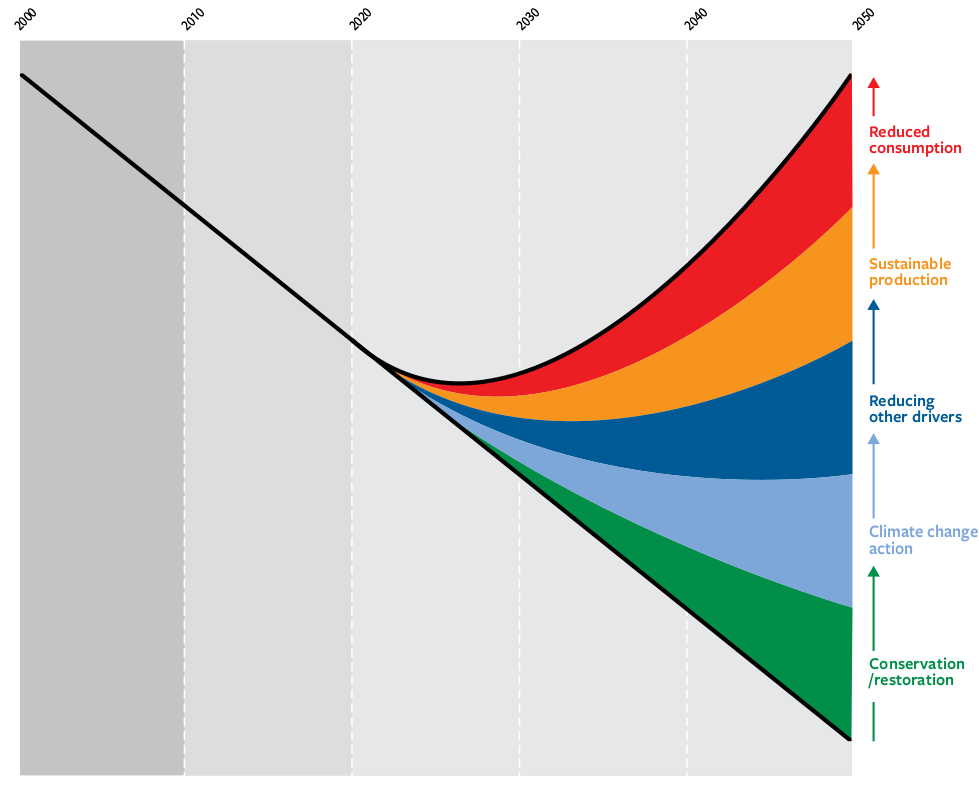The decline of biodiversity on our planet and how we can rewilde nature

We need to restore our ecosystems now – for climate, nature and people

The UN Decade on Ecosystem Restoration is a rallying call for the protection and revival of ecosystems all around the world, for the benefit of people and nature. It aims to halt the degradation of ecosystems, and restore them to achieve global goals. Only with healthy ecosystems can we enhance people’s livelihoods, counteract climate change, and stop the collapse of biodiversity1.
A Dutch initiative
Land van Ons (Land of Ours) is a fast-growing citizens’ cooperative that purchases agricultural land on behalf of more than 13,000 participants. On these parcels of land, they restore biodiversity and landscape and allow tenants to farm sustainably.
An English transcript of this video2:
For centuries, there was plenty of nature within the Dutch farming landscape on and between agricultural plots. But from the 1950s onwards, everything had to be bigger and
more efficient via land consolidation. Huge contiguous areas with monocultures emerged where there was hardly any room left for nature. Of the number of native plants and animal species we had in 1900, now less than half left.
“Land of ours” is therefore working towards a sustainable agricultural transition. We believe that producing food and healthy biodiversity can and should go hand in hand. Therefore, as a cooperative, we buy farmland and, together with organic farmers, give nature an important place here again. Soil plays a central role in this.
This is because the soil of much farmland is under severe pressure from nitrogen,
dehydration, poisoning and compaction and therefore contain little life. Whereas a healthy soil is teeming with life. Much of this life cannot be seen with the naked eye, if at all. Bacteria, fungi, nematodes and all kinds of other micro-organisms live below the surface. All these tiny inhabitants are essential to the fertility and productive capacity of the land and are thus at the basis of all life in an area.
On the “Land of ours” plots, therefore, only shallow ploughing and lighter machinery is used, to leave the top soil layer intact as much as possible intact. We stimulate soil life even further through the method of fertilisation. We deliberately do not use artificial fertilisers and pesticides, but let a mix of herbs and plants grow on the land outside the high season. These enrich the soil with their organic matter and hold the top soil layer very well. Our cows have plenty of space and are in the pasture as much as possible, separating their poo and pee and reducing ammonia in the air. The manure in the barn is separated from the urine as much as possible and mixed with straw or other bedding to get solid manure, which is better for soil diversity.
To further encourage soil diversity, we bring back variation in the landscape on all our plots. Often we plant hedges, trees and hedgerows, but on other plots we dig pools, ditches or ponds, or we let a herb-rich grassland grow. All this variation in the landscape creates opportunities for plant species that have long struggled in the farmed landscape. These returning plant species, the flower strips and the beetle banks attract all kinds of new inhabitants. which actually enhance the productivity of the land.These insects contribute to improved yields, by pollinating crops. Through sowing the right plant species and hedges, enemies of pests are attracted. And using strip cropping, where different types of crops grow side by side, further enriches biodiversity and makes crops much less vulnerable to disease than with just one crop. Birds flock to the buffet of pollinating insects in field margins. Waterbirds feast on worms in the wet areas and meadow birds find their way back to the herbaceous grassland they share with livestock. Kestrels and buzzards lurk for an outside chance. But fortunately there are also plenty of hiding places and in spring there is ample choice for nest building. Larger inhabitants such as hares and roe deer also use the flower strips, hedges and ramparts as hiding places and natural connecting paths between surrounding nature reserves. Hedgehogs and mice can look for worms, snails and insects or an abandoned nest here, while they again have to watch out for larger predators.
What started as a barren, monotonous piece of land is thus turning into a colourful area where biodiversity and productivity go hand in hand. “Land of Us” believes in a healthy and productive Dutch agricultural area in which fields and meadows are not an interruption of, but complementary to a connection between nature reserves.
If you want to work with us on a farmland full of life, go to www.landvanons.nl and see how you can help us.
An American initiative
To me one of the most inspiring films is “The Biggest Little Farm”, a beautiful example of rewilding.
- Decade on Ecosystem Restoration
https://wedocs.unep.org/bitstream/handle/20.500.11822/31813/ERDStrat.pdf
↩︎ - The transcript is generated using DeepL, based on the Dutch transcript on the Youtube page. Disclaimer: I do not own the rights of this video. I just want to share this inspiring initiative with many people. ↩︎